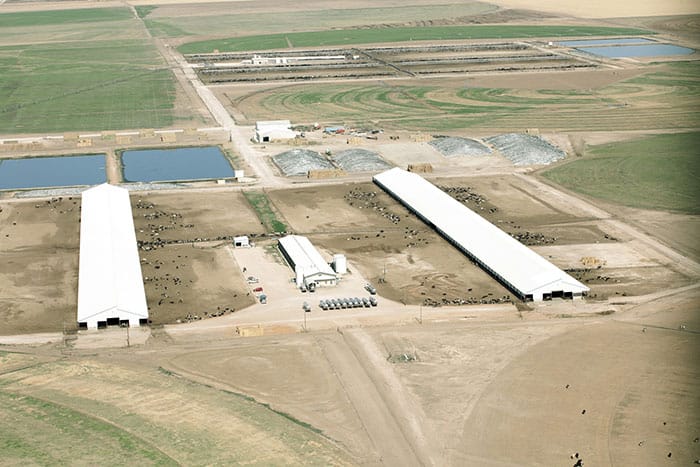Will the US government incorporate environmental impacts into dietary guidelines for the first time? Or will it blink?
The Guardian
by Garrett Hering
 |
When a federal advisory committee created the first federal proposal to explore the relationship between nutrition and the environmental impacts of the American diet in December, it unsurprisingly drew the ire of meat producers and their allies in Congress.
It’s not hard to see why. One of the committee’s central findings was that: “A dietary pattern higher in plant-based foods … and lower in animal-based foods is more health promoting and is associated with lesser environmental impact than is the current average US diet.”
This month, Secretary of Agriculture Tom Vilsack and Secretary of Health and Human Services Sylvia Mathews Burwell will review the dietary advisory committee’s final report before releasing it to the public for comment. The report, in turn, will provide the scientific basis for the upcoming eighth edition of the federal government’s dietary guidelines for Americans – a highly influential policy document that the government publishes every five years.
“The reason to include sustainable diets, a new area to [the committee], is to recognize the significant impact of foods and beverages on environmental outcomes,” explained Miriam Nelson, a professor at Tufts University who heads the subcommittee on sustainability and safety.
Where’s the beef?
Following the committee’s December 15 meeting, meat industry groups expressed outrage over the removal of “lean meats” as a component of healthy diets. Noting that the government’s 2010 guidelines included lean meats among its dietary recommendations, Barry Carpenter, president of the North American Meat Institute, called this year’s omission “arbitrary and capricious”.
In a letter addressed to officials at the Department of Agriculture and the Department of Health, Carpenter claimed that the committee’s recommendation “reflects either an astonishing lack of awareness of the scientific evidence or a callous disregard of that evidence, again calling into question the entirety of the recommendations submitted by the [committee] to the agencies”.
He predicted “serious, adverse consequences” for America’s health if the recommendations presented in December were to make the final cut into the actual policy document to be released later this year.
“This risk would become real if the agencies incorporate this recommendation into federal policy because it will affect many programs”, including school lunch programs and other food and nutrition initiatives.
The federal advisory committee also advised that a “moderate amount of seafood is an important component of many of the dietary patterns associated with improved health and sustainability”. This includes both farm-raised and wild-caught fish.
Meat producers also questioned the report’s focus on sustainability. Chase Adams, a spokesman for the National Cattlemen’s Beef Association, declined to comment on the possible impact of the committee’s recommendations on the beef industry. He did, however, suggest that the report overshot its purview.
“Production practices are not a part of the dietary guidelines as authorized by Congress,” Adams said, referring to the year-end appropriations bill, in which Congress directed Secretary Vilsack to address only direct dietary information, not “extraneous factors”, in the guidelines.
In December, the meat industry and other opponents of the draft recommendations set up a new umbrella group, the Back to Balance Coalition, aimed at combating “public policy efforts occurring at the local, state and national levels to malign and restrict certain foods”. Among its members are the American Association of Meat Processors, American Meat Institute, American Frozen Foods Institute, Canned Food Alliance, Snack Food Association and the Sugar Association.
Eating: the most powerful impact on the environment
Environmental groups and independent food researchers welcomed the move to incorporate sustainability into US dietary guidelines.
“Our health is not bound by our bodies but reflects the health of the entire food chain from which we eat,” Michael Pollan, author of The Omnivore’s Dilemma, told the Guardian. “Many people don’t yet think of their eating as their most powerful impact on the environment, but it is and this would serve as a salutary reminder,” he added.
Martin Heller, a researcher at the University of Michigan’s Center for Sustainable Systems, said that it was too early to tell if the 2015 guidelines would actually help reduce food-related greenhouse gas emissions given the uncertainties over which recommendations will be included in the end.
“I also expect that there are recommendations that can be supported by current nutritional health research – such as reduced consumption of red meat – that don’t make it into the 2015 guidelines that would most certainly lead to further reductions in diet-related greenhouse gas emissions,” he said.
Kari Hamerschlag, a food expert at environmental group Friends of the Earth, hopes that the Obama administration will stand its ground. “There is no doubt the USDA and the USHHS are under intense pressure from the meat industry and their defenders in Congress to squash important information about the major environmental impacts of food production,” she said.
Committee members and government agencies have declined to comment on reactions to the recommendations until the final report is published at the end of February.
The Vital Signs platform is funded by Avery Dennison, Domtar and Chiquita. All content is editorially independent except for pieces labelled advertisement feature. Find out more here.

